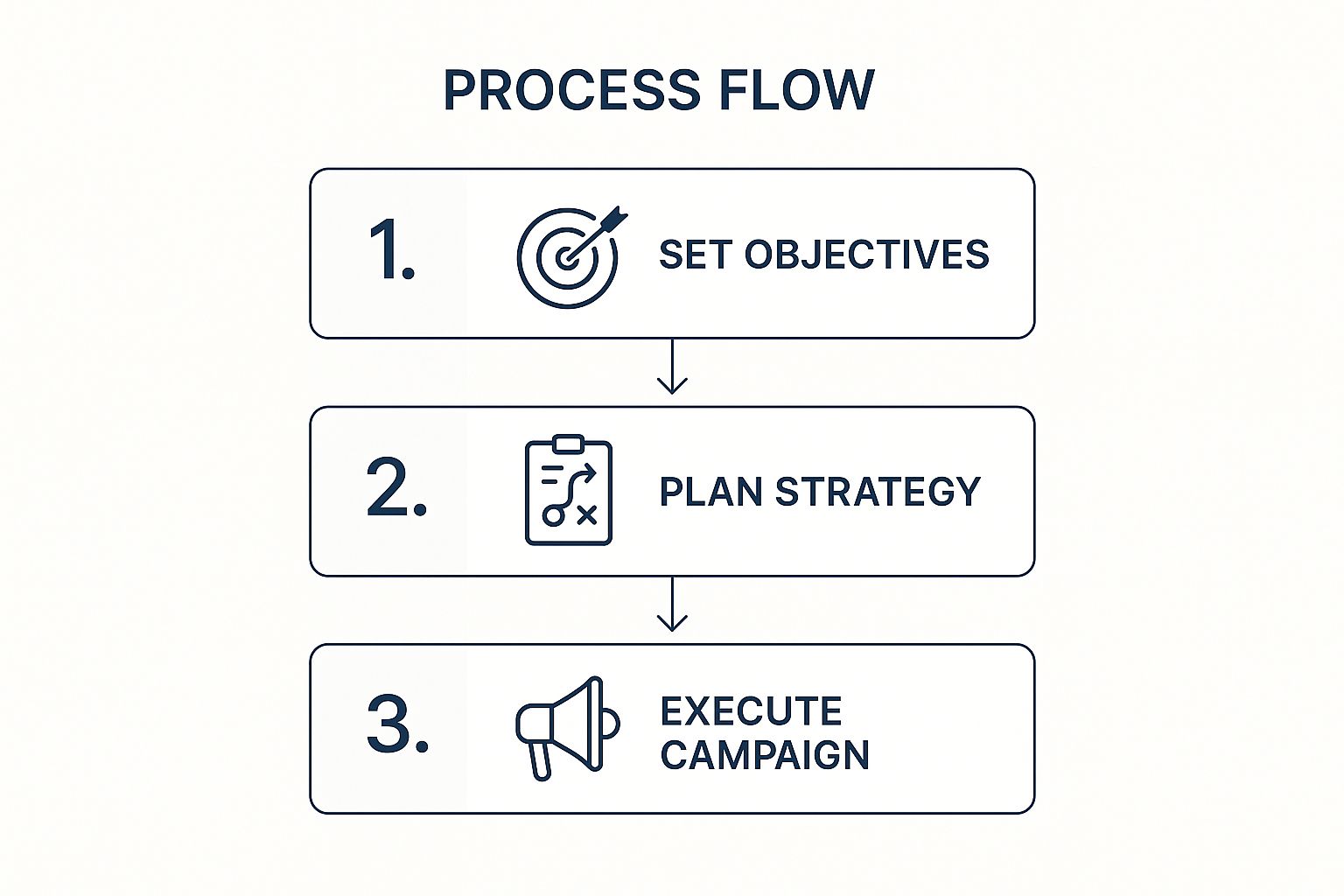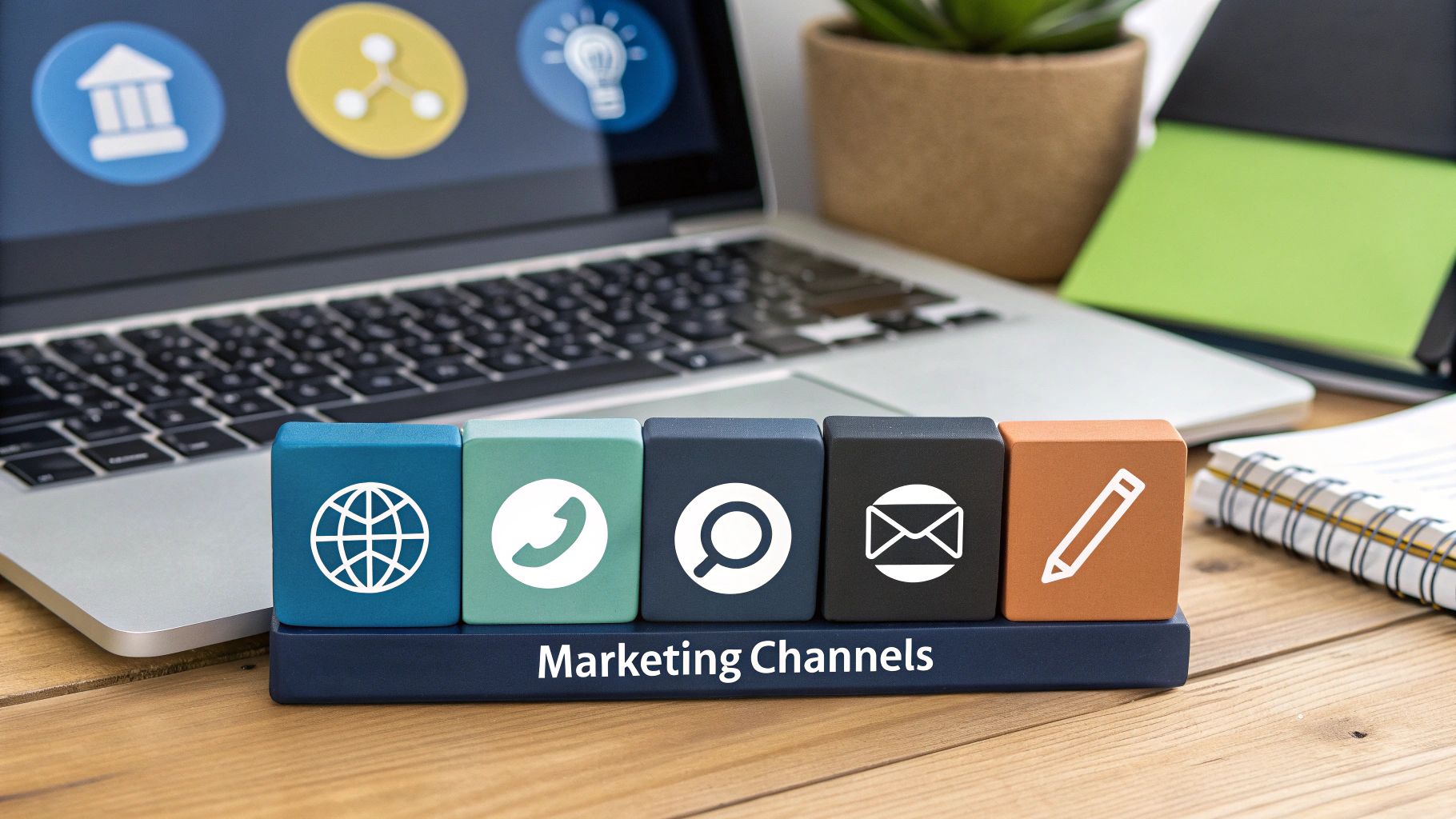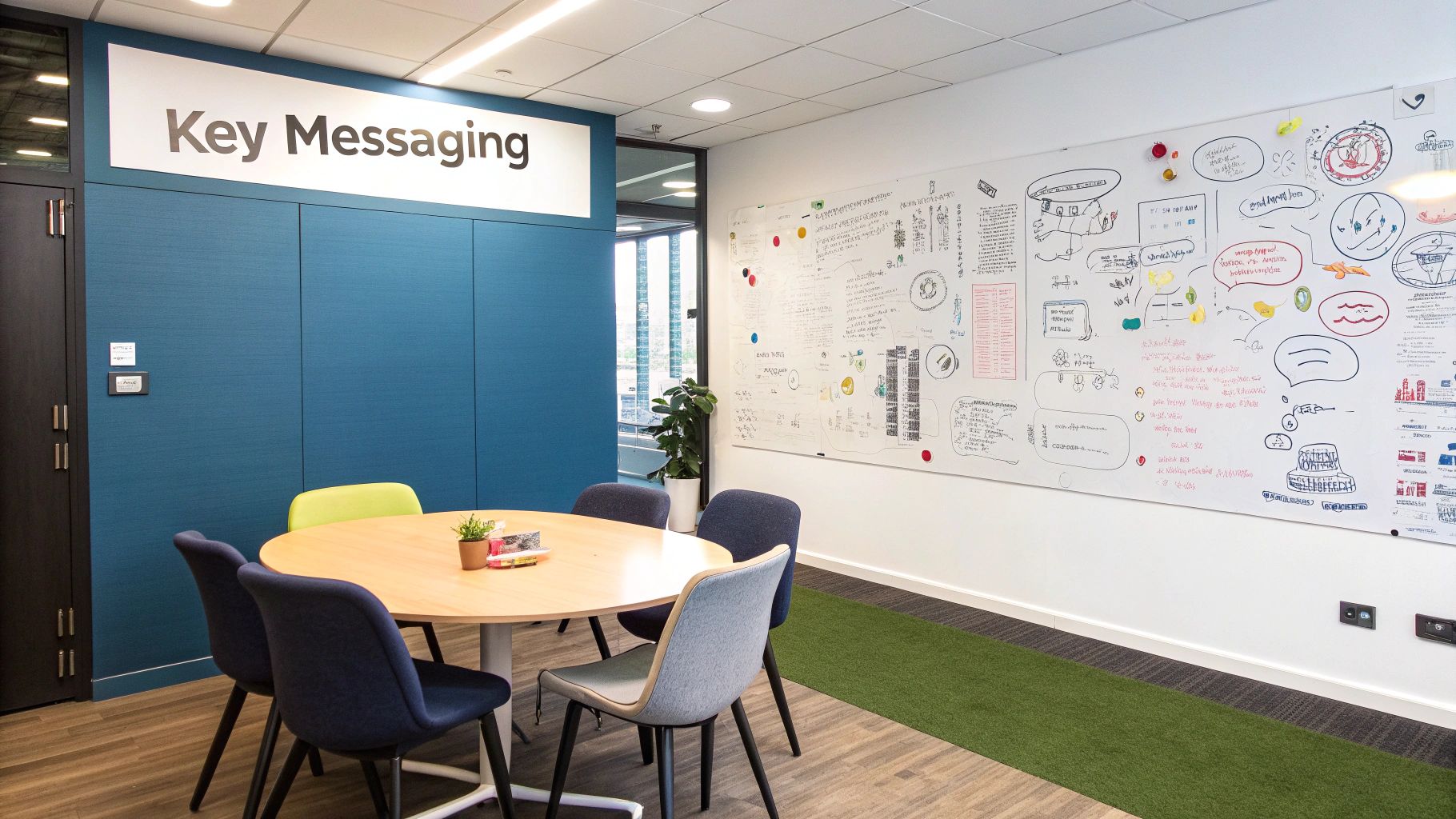Before you even think about flashy creative or clever copy, every successful marketing campaign begins with a solid, strategic foundation. It's the unglamorous but essential work of setting clear goals, zeroing in on your target audience, and creating a realistic budget. Get this right, and every decision that follows becomes smarter and more effective.
Building Your Campaign's Strategic Foundation
Jumping straight into designing ads or writing social media posts without a plan is a classic mistake. It's like building a house with no blueprint—it might look okay for a little while, but it's destined to fall apart. A strong foundation ensures your efforts are focused, efficient, and actually move the needle on your bigger business objectives.
Setting Clear and Measurable Goals
Your campaign goals are your compass. They need to be specific, measurable, achievable, relevant, and time-bound (SMART). Vague goals like "increase brand awareness" just won't cut it. You need something concrete to aim for.
Think in terms of tangible outcomes:
- Increase website traffic by 20% in the next quarter.
- Generate 150 qualified leads from the campaign within 60 days.
- Achieve a 5% conversion rate on the new product landing page.
These kinds of goals give you clear targets and make it easy to see if you're actually succeeding. If you don't know what you're trying to accomplish, you're just throwing money at the wall and hoping something sticks.
Key Takeaway: A campaign without clear KPIs is an expensive hobby. Define what success looks like in specific numbers before you spend your first dollar.
This whole process—from high-level objectives to the final execution—is a logical flow.
As you can see, each stage builds directly on the one before it, making sure your execution is grounded in a solid strategy from the very start.
Defining Your Audience and Budget
Who are you actually talking to? You need to know them inside and out. Go beyond basic demographics and build detailed audience personas. What are their biggest frustrations? Where do they hang out online? What truly motivates them to buy something?
Getting these answers right is how you craft a message that genuinely connects. A deep understanding of your audience is also the first step toward building a thriving online community, which you can learn more about here: https://reach-influencers.com/how-to-build-online-community/
With a crystal-clear picture of your audience, you can finally set a practical budget. This shouldn’t be a random guess. Allocate your resources based on the channels where your audience is most active and the goals you've set. For instance, if your main goal is lead generation and you know your audience lives on LinkedIn, it makes sense to put a significant chunk of your budget there. To really get this right, it helps to understand how to create the best AI marketing strategy for your business, as modern tools can seriously optimize how you allocate your spend.
To tie this all together, think of your campaign's foundation as a set of core components. Each one answers a critical question that guides your entire strategy.
Core Components of a Campaign Foundation
| Component | Key Question to Answer | Example |
|---|---|---|
| Objectives | What is the primary business outcome we want to achieve? | "We need to generate 150 marketing-qualified leads in Q3." |
| Audience | Who is the ideal person we need to reach to hit that goal? | "Marketing managers at B2B SaaS companies with 50-200 employees." |
| Budget | What is the maximum we can invest to acquire that customer? | "Our max cost-per-lead is $75, so our budget is $11,250." |
Nailing down these three elements—your objectives, audience, and budget—is non-negotiable. They form the bedrock of your entire campaign, ensuring that every dollar and every hour you spend is pushing you closer to a meaningful result.
Choosing Channels and Crafting Your Message
Alright, you've got your goals locked down and you know exactly who you're talking to. Now comes the fun part: deciding where to show up and what to say. This is where your strategy starts to feel real.
It's tempting to try and be on every single platform, but that’s a classic rookie mistake. Spreading yourself too thin just means your budget gets diluted and your message gets lost in the noise. The real win is in focusing your efforts where your ideal customers are already hanging out.
If we look at the trends for 2025, a couple of areas are impossible to ignore. Social media and influencer marketing aren't just buzzwords; they're foundational to a modern campaign. The global social media ad market is expected to jump by 12%, and 59% of marketers are planning to increase their work with influencers.
And for good reason. A staggering 76% of people on social media say their buying decisions are shaped by what they see in their feeds. These channels flat-out drive business. For a deeper look, the latest digital marketing statistics paint a pretty clear picture.
Picking the Right Playground for Your Brand
Choosing your channels isn't about jumping on the latest trend—it's about being strategic. Let your audience personas be your compass here.
Are you trying to reach B2B professionals? LinkedIn and niche industry forums are probably your best bet. If you’re talking to a younger crowd, you'd be crazy not to be on TikTok and Instagram.
Here’s a simple framework I use:
- Fish where the fish are. Don’t waste energy trying to pull your audience to a new platform. Meet them where they've already built communities and habits.
- Match the channel to the goal. If you want broad brand awareness, video-heavy platforms are perfect for telling a story. But if you're after direct sales, search engine marketing can capture people who are ready to buy right now.
- Be realistic about content. Can your team actually create the kind of content that thrives on that channel? A YouTube strategy sounds great, but it requires a solid video production workflow.
This is where influencer collaborations can be a secret weapon. They let you tap into an existing community that already trusts the creator. This is especially powerful when you partner with niche creators who have a dedicated, engaged following. A great starting point is learning the ropes with a guide to micro-influencer marketing, as these partnerships often deliver fantastic engagement and a solid return on your investment.
Creating a Message That Actually Connects
Once you know where you'll be, you have to nail down what you’ll say. Your core message needs to be simple, memorable, and speak directly to your audience's biggest headache. This isn't the time to list out all your product features. It’s about the one big idea that holds your entire campaign together.
A great message doesn't just describe what you do. It frames the problem your customer has and positions your solution as the obvious, most compelling answer.
Let's take a real-world example. Imagine a small business owner who’s drowning in financial admin. A generic message is, "Use our accounting software." It's true, but it's boring.
A message that connects sounds more like this: "Stop wasting weekends on spreadsheets. Get your books done in minutes." See the difference? The second one hits a specific pain point and promises a clear, desirable outcome. This is your value proposition, and it should be the consistent thread that runs through all your channels, even as you tweak the creative for each one.
Developing Your Campaign's Creative Assets
This is where all the abstract planning finally takes shape. All that research and strategy gets a personality, turning into the tangible visuals, copy, and videos your audience will actually see and interact with. Think of your creative execution as the campaign's front line.
The first move is to translate your strategic goals into a clear creative brief. This document is your North Star, keeping everyone from designers to copywriters perfectly aligned. It doesn't need to be a novel, but it absolutely must be clear.
Your brief should nail down a few key things:
- The primary objective: What’s the single most important action this creative should drive?
- The core message: If the audience remembers only one thing, what is it?
- The target audience: Who are we really talking to, and what makes them tick?
- Key deliverables: What specific assets do we need? Be precise—three Instagram Reels, one landing page, two email templates, etc.
Once you have a solid brief, you can start building out assets that are purpose-built for each channel. A high-energy, vertical video ad might be perfect for social media, while a detailed, thoughtful article is what you need to capture search traffic.
Aligning Creative with Your Core Message
Authenticity is the secret sauce here. Your creative assets can’t just look good; they have to feel genuine to your brand and connect with your audience on a deeper level. For example, if transparency is a core brand value, your visuals should be clean and direct, not cluttered and confusing.
A huge part of modern authenticity is communicating your brand's values, especially around social responsibility. Sustainability is a perfect example. It's no longer a niche concern—research from Kantar shows that 93% of consumers want to live more sustainably, and this directly influences where they spend their money.
This isn’t just about ethics; it's a massive market opportunity. Sustainability is already estimated to contribute $193 billion to the value of the world's top brands.
Don’t just tell people what you value—show them. If sustainability is a core principle, incorporate eco-friendly packaging in your product shots or feature partners who share your commitment. This builds trust far more effectively than a simple claim.
At the end of the day, your creative assets are the bridge between your strategy and your customer. When you create a marketing campaign, the visuals and the words are what people remember. Make sure they’re authentic, tailored for the right channels, and built from a clear, unified brief. That’s how you give your campaign the best possible shot at connecting with people and getting results.
Taking Your Campaign Live: The Launch Sequence
This is it. The moment all that planning, negotiating, and creating has been leading up to—it's time to go live. A successful launch isn't just about flipping a switch; it's a carefully timed process that starts long before the "publish" button is clicked and continues well after. This is where your strategy meets the real world.
Your absolute best friend during this phase is a detailed launch checklist. Trust me, it prevents those last-minute panic attacks and ensures nothing critical gets overlooked. Think of it as a pilot's pre-flight check.
Your list should cover everything from final sign-offs on all influencer content to confirming tracking pixels are firing correctly. And please, double-check every single link and landing page. This simple document is often the only thing standing between a smooth takeoff and a chaotic mess.
Phased Rollout or Big-Bang Launch?
One of the biggest calls you'll make is how you introduce your campaign. You’ve really got two main paths, and each has its own pros and cons depending on what you're trying to achieve.
- Big-Bang Launch: This is your all-in, high-impact approach. Every piece of the campaign goes live at the same time, across all channels. It’s perfect for creating a huge splash, like for a new product drop or a major brand event. The catch? It's high-risk. If something's broken, it's broken for your entire audience, all at once.
- Phased Rollout: With this method, you introduce the campaign to a smaller audience segment or on just a few channels to start. This lets you collect initial data, squash any bugs, and fine-tune your messaging before you go wide. It’s a much safer, more controlled way to make sure everything is working perfectly.
The right choice really boils down to your risk tolerance and campaign goals. A time-sensitive holiday promotion might need the urgency of a big-bang launch. But for a complex, multi-channel effort, a phased rollout gives you an invaluable safety net for testing and learning.
Managing the Campaign in Real-Time
Going live isn't the finish line; it’s the starting gun. The real work begins now, and active management during the first 24-72 hours is absolutely critical. Don't be the person who launches a campaign on Friday and doesn't check the dashboard until Monday morning.
Keep a close eye on your key metrics right from the start. Are your click-through rates anywhere near your projections? Is the cost per acquisition staying within your budget? This early data is telling you a story, and you need to be ready to listen—and react fast.
This is also prime time for monitoring audience engagement. Get in there and respond to comments, answer questions, and just get a feel for the sentiment. This kind of qualitative feedback is just as valuable as your analytics; it gives you a raw, unfiltered look at how people are really responding to your message. If you spot an unexpected problem or a surprising win, don't wait to make adjustments. That's how you turn a potential issue into a powerful optimization opportunity.
Measuring Performance and Optimizing for Growth
Getting your campaign live is a huge milestone, but it's really just the beginning. The real work—and where you’ll see the biggest wins—starts when you dig into the data. This is where you transform numbers on a screen into smart decisions that fine-tune your strategy for even better results.
Forget vanity metrics. Likes and follower counts might feel good, but they don't tell you if the campaign is actually working. You need to zero in on the Key Performance Indicators (KPIs) that connect directly to the SMART goals you set from day one. If you were aiming for lead generation, your North Star is Cost Per Lead (CPL), not video views.
Identifying Your Core Campaign Metrics
Every campaign should have a handful of essential metrics that paint a clear picture of its health. Think of them as your campaign’s vital signs. While your specific KPIs will depend on your goals, a few are almost always part of the conversation.
- Conversion Rate: This is your gut check. What percentage of people are actually taking the action you want them to? Whether it's signing up for a newsletter or buying a product, this metric tells you how persuasive your campaign really is.
- Customer Acquisition Cost (CAC): Simply put, how much are you spending to bring in each new customer? If this number is creeping up higher than what a customer is worth to you over time, it’s a red flag.
- Return on Ad Spend (ROAS): For every dollar you spend on ads, how many are you getting back? This is the bottom-line metric that cuts right to the financial impact of your campaign.
Keeping a close eye on these numbers in a tool like Google Analytics is essential. It helps you see not just what's happening, but gives you clues as to why. Once your campaign is running, learning how to measure advertising effectiveness is what separates the pros from the amateurs. It’s how you become a strategist, not just someone who launches ads.
Embracing Continuous Optimization
The best campaigns I’ve ever seen were never “set it and forget it.” They were living, breathing things that were constantly tested and improved. This is where A/B testing becomes your best friend. By isolating and testing one variable at a time—a headline, a photo, a call-to-action—you can make informed decisions that methodically improve performance.
When it comes to your influencer partnerships, you need to go deeper than surface-level stats. Inside the REACH platform, you get detailed analytics that show you exactly which influencers are driving the most clicks, conversions, and actual sales. For a full breakdown of how to do this, take a look at our guide on measuring influencer marketing ROI.
Expert Tip: Don't just focus on massive overhauls. We once saw a 15% lift in conversions on a landing page just by changing the button color from blue to orange. Small, iterative tests can produce surprisingly big results.
This data-first approach is what’s driving the entire industry forward. The global artificial intelligence (AI) marketing market was valued at $20 billion back in 2022 and is on track to double to $40 billion by 2025. That explosive growth underscores just how critical data-driven tools have become. By making analytics and continuous improvement part of your process, you ensure your campaign doesn’t just launch—it evolves, adapts, and delivers better returns over time.
Got Questions? We've Got Answers
When you're in the trenches of planning a new marketing campaign, a few questions always seem to pop up. Getting these right is often what separates a killer campaign from a swing and a miss. Let's dig into some of the most common questions I hear from marketers just like you.
"How Much Should I Actually Budget for This?"
This is the big one, isn't it? While there’s no universal price tag, a solid rule of thumb is to set aside 5% to 12% of your company's total revenue for marketing. If you’re just starting out, I’d strongly advise sticking to the lower end of that range. Think of it as your pilot program.
The real key here is to avoid the "peanut butter" approach—spreading your budget thinly across every channel you can think of. That's a recipe for mediocrity. Instead, focus your money where your audience already lives and breathes.
I always recommend a "test and invest" model:
- Pick two or three channels that your gut (and your data) tells you have potential.
- Run small, controlled tests for a few weeks and watch the numbers like a hawk.
- Double down on the winner. Once you see a channel delivering real ROI, that's where you put your bigger investment.
And don't forget the hidden costs! Your budget needs to account for more than just ad spend. You've got creative work, software subscriptions, and especially any fees for your influencer partners.
"What Metrics Should I Be Watching?"
The metrics you track are only as good as the goals you set. Chasing vanity metrics is the fastest way to burn through your budget with nothing to show for it. Always tie your Key Performance Indicators (KPIs) directly back to your campaign's primary mission.
For a brand awareness campaign, you’re looking at things like:
- Reach: How many unique people laid eyes on your content?
- Impressions: How many times was your content displayed in total?
- Engagement Rate: The classic combo of likes, comments, and shares, measured against your reach.
But if you're running a lead generation campaign, the game changes. Your focus should be on:
- Cost Per Lead (CPL): Simple and powerful—what's the price tag for each new lead?
- Conversion Rate: What percentage of people actually did the thing you asked them to do (like sign up for a demo)?
For a straight-up sales campaign, it all comes down to Return on Ad Spend (ROAS) and Customer Acquisition Cost (CAC). Don't let yourself get sidetracked by a high number of likes if those likes aren't turning into dollars.
My biggest piece of advice? Don't overcomplicate it. Pick three to five core metrics that give you a crystal-clear signal on whether things are working or if you need to pivot.
"Help! My Campaign Isn't Working. What Now?"
First off, take a deep breath. An underperforming campaign isn't a failure—it's market research you just paid for. The trick is to diagnose the issue systematically, not just start changing things at random.
Start by following the data. Where's the drop-off? If you have low click-through rates (CTR), the problem is probably at the top of the funnel. Your ad creative, your copy, or your audience targeting just isn't resonating. It’s not stopping the scroll.
On the other hand, if you're getting tons of clicks but almost no conversions, the problem is on your landing page. Maybe the offer is confusing, the page is slow to load, or there's a disconnect between what your ad promised and what the page is delivering. That friction kills conversions.
The best way to fix this is with methodical A/B testing. Test one thing at a time—the headline, the image, the call-to-action button color. This is the only way to know for sure what actually moves the needle. And hey, don't forget to read the comments. Your audience will often tell you exactly what’s wrong in their own words.
Ready to stop guessing and start getting real, measurable results from your influencer collaborations? REACH gives you the tools to discover the perfect partners, manage your entire outreach workflow, and track performance in one spot. Find your ideal partners today!






